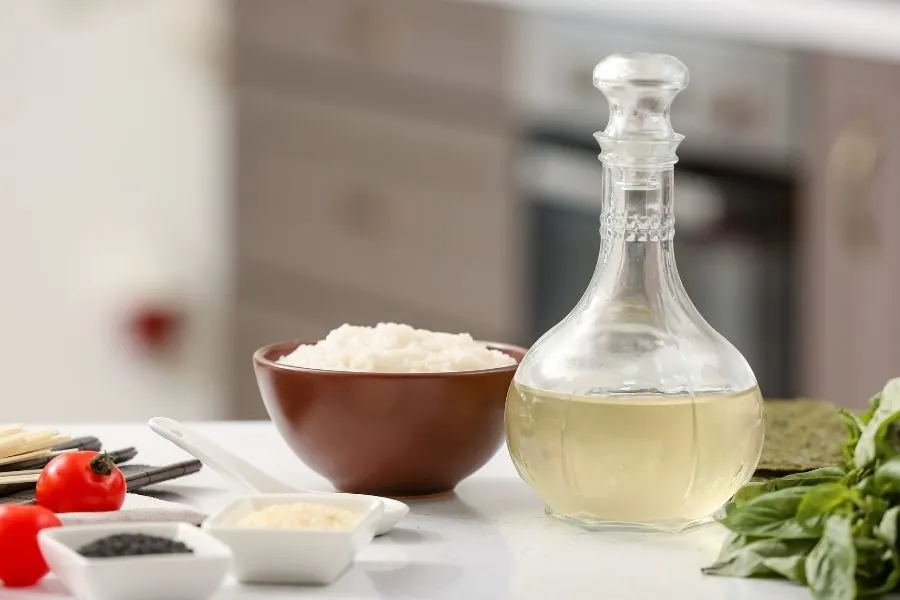The tarragon plant is also known to many people under the name of estragon. It is a species from the sunflower family. Its origin is in North America and it is used in vinegar in France.
But if you don’t like the taste or can’t get your hands on this addition, there are plenty of substitutes you can use instead. This plant is used in vinegar as a salad dressing or for medicinal purposes.
The world of herbs is a fun and complex experience, a lot of people enjoy mixing and trying out different flavors. If you are one of them and you wish to try out new things in your kitchen, we got you.
There are so many recipes you can even better by using substitutes. So for whatever reason, personal preference, or the inability to buy the ingredient you need, you can use any substitute similar to it. And we will show you how.

Substitute for tarragon vinegar
The best substitute for tarragon vinegar is white wine vinegar, as it’s the simplest vinegar and most readily available. Depending on why you need the vinegar, you may add dried tarragon leaves or substitute for marjoram, basil, dill, or any herb you like.
You can also make your own tarragon vinegar at home.
All you need is a clean, large jar, hot white wine vinegar, and fresh tarragon leaves. Let the tarragon soak in the vinegar for about 2 weeks, make sure the jar is sealed very well.
After 2 weeks strain the vinegar and bottle it as you like.
Now, what if you don’t have the time or the means to make tarragon vinegar at home ? Well, you can remember that very short recipe and use it at a later date.
And in the meantime, you can take a look at these other tarragon vinegar substitutes you can try.
Read also : Best Apple Butter Substitutes
A few words about tarragon vinegar
Tarragon is very popular in the French kitchen and it is often paired up with fish, chicken, or eggs. It is also the main ingredient in Béarnaise sauce.
This famous sauce is made of butter and egg yolks with the addition of white vinegar. It is similar to the Hollandaise sauce but differs in flavor because it uses chervil, tarragon, shallot, and peppercorns.
Perhaps you have already heard of this vinegar, but if you haven’t here is all you need to know. It is made by tarragon being steeped in vinegar. It is as simple as that. So if you can find some herbs you could make your own.
It might be a bit tricky to pair the perfect substitute with a meal so you need to do some research if you wish to be called an expert by your family and/or guests. Some recipes require less of it so you can barely go wrong, but for dishes that require your dish to swim in tarragon vinegar, you need to be more careful.
It is great for salad dressings since it is completely vegan. There are different types of tarragon vinegar. Some are intense while some are pretty mild. It depends on the time you let the herb steep in vinegar, and how much tarragon you use.
And remember that any recipe is susceptible to change. It is not a rule but merely a suggestion of someone else’s experience they recommend. So feel free to use any of these substitutes. You can simply use white wine or regular vinegar without fear.
Substitutes for tarragon vinegar
In the first part of the post we talked about the best substitute for tarragon vine, But there’s more than one. White wine is the best, but there are a few others you can use if you can’t get white wine.
So let’s explore each option so we know what we’re substituting for.
White Wine
The first one the list of substitutes for tarragon vinegar is white wine. And better yet, dry white wine. It is very versatile in its use. It can be used as an additional acidic flavor in risottos or pasta dishes. It can also be used to cook mushrooms, poultry, or fish.
Choose a dry white wine vinegar to avoid sweetness, but if you enjoy it then add some regular wine vinegar of your taste. Sparkling wine vinegar can also be a great option if you wish your chicken turns out crispy.
Avoid full wines that have intense flavors since they differ from the original taste of tarragon vinegar too much so they don’t make a good substitute.

Lemon Juice
Lemon juice is another great alternative for tarragon vinegar. It is very popular and highly used in the European kitchen, especially in the Mediterranean recipes.
Not only can lemons come in handy when you need some additional flavor for your daily intake of water or tea, but they make a great cooking companion.
Lemon juice can be used in sweet desserts or savory dishes and it helps digest fried foods which is why it is often used with fish or poultry. It can be a great addition to your salad dressing. If you dislike the taste of vinegar, you can use lemons to add some acidity without the aftertaste of vinegar.
Balsamic vinegar
Balsamic vinegar can be as sweet as you would like it to depending on the aging process. You can buy less expensive ones for salad dressings or marinades, and more expensive ones for vegetable or cheese dishes.
Read Also:What Does Balsamic Vinegar Taste Like ?
Apple cider vinegar
Apple cider vinegar is a mild option and goes well with fish and poultry. Since it is so acidic you need to keep it in a cool place at all times. It may also have a sweet aftertaste that may change the dish’s flavor.
Unless you’re fine with some extra sweetness. If you are, then you’ll notice ACV bring a very fruity note that may just lift up a sauce or mayonnaise.
Rice vinegar
Rice vinegar is the mildest and most versatile due to rice being a very mild flavor. While it isn’t the strongest vinegar, it’s definitely an option for those who find ACV or white wine vinegar too much.
Also, whatever herb or flavoring you add to rice vinegar will stand out more, since there is no overpowering flavor.

Add herbs to the vinegar
When you add the vinegar to your recipe, you may also add an herb or two. It really depends on the recipe. If the recipe asked for tarragon vinegar for a strong flavor, then you may want to add an herb.
If it only asked for tarragon vinegar to have a bit of vinegar in it, you can skip the herb.
Still if you want to use herbs here are some good substitutes for tarragon. They won’t be the same, as tarragon has a very unique flavor, but they will flavor your meal nicely.
Herbs such as thyme, chervil, and oregano are incredible to have in the kitchen if there is no tarragon. Thyme is popular among Italians since it goes well with vegetables, fish, and poultry. It goes well with sweet dishes, oranges, and apples.
Oregano, however, goes better with salty and acidic dishes so pair it up with lemons, eggs, and tomatoes.
Chervil has a taste pretty similar to parsley and is mild, while oregano is one of the most famous herbs to use.
So try out new dishes to decide which taste is for you. Then you are ready for experimenting with these substitutes according to your preference and expectations.
Conclusion
There are a lot of great substitutes for tarragon vinegar, so you can go for the one that is suited for the recipe you are going for. Keep in mind that the tarragon has a strong taste so you will not have that in your food if you substitute the tarragon vinegar but the food can still be good.

